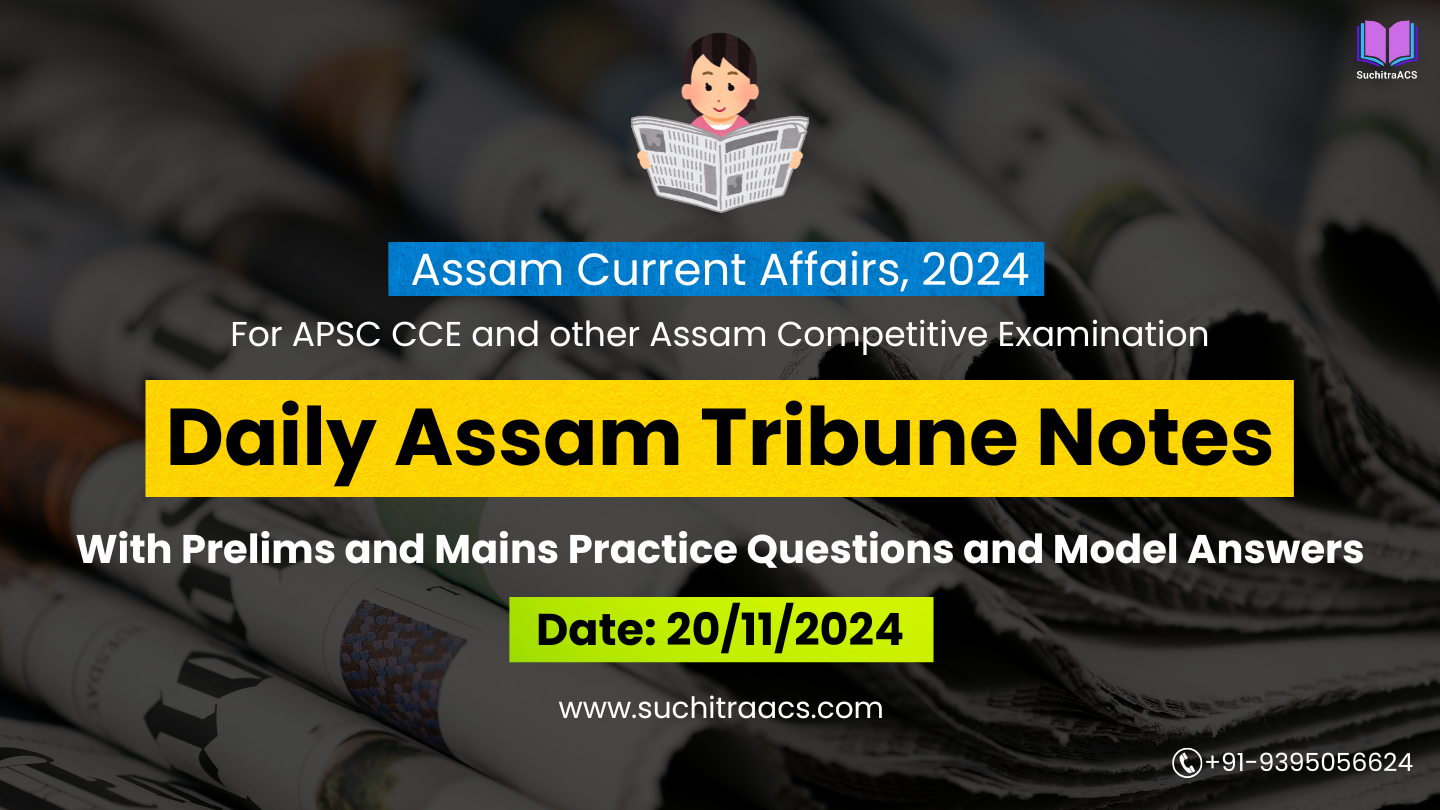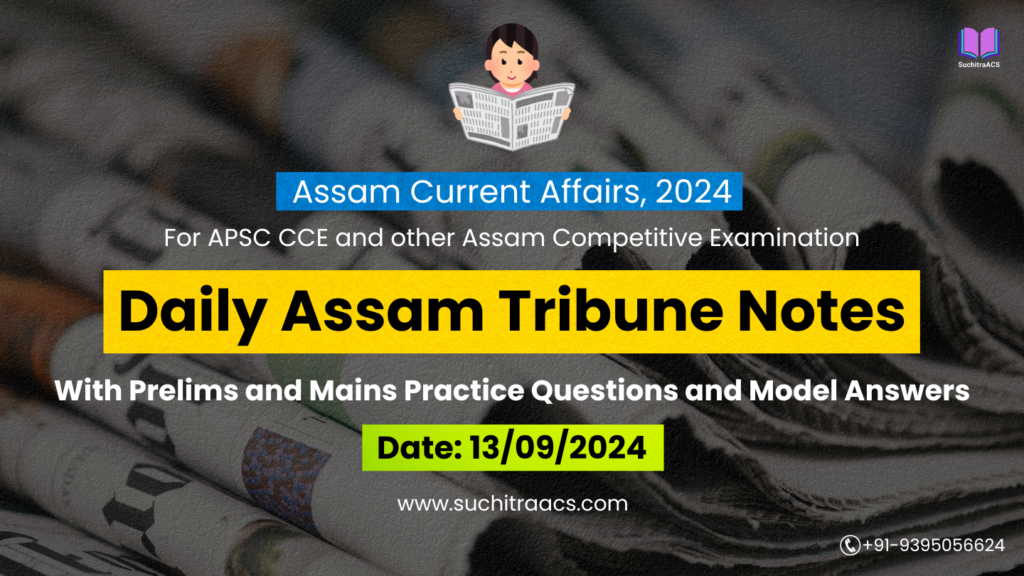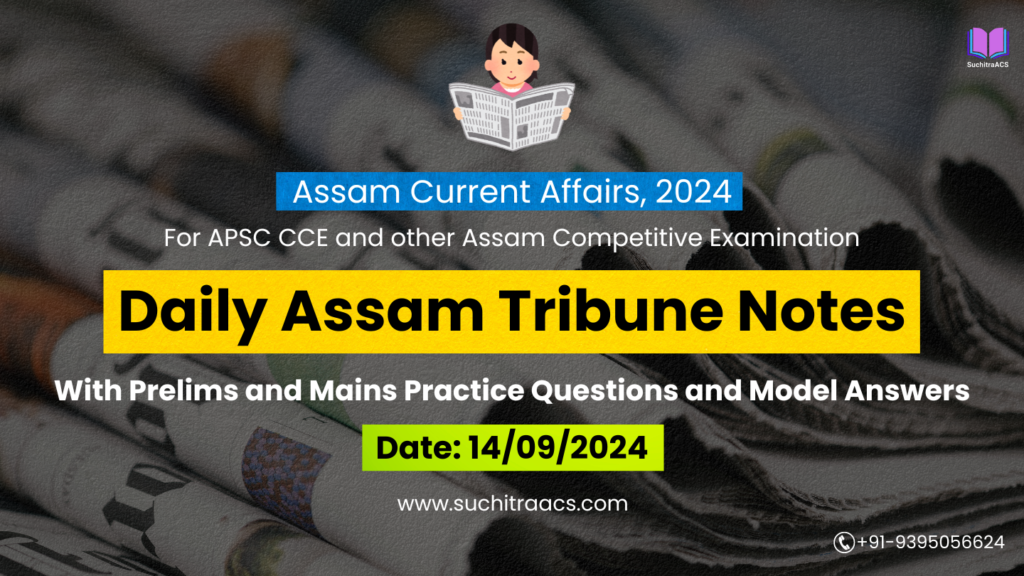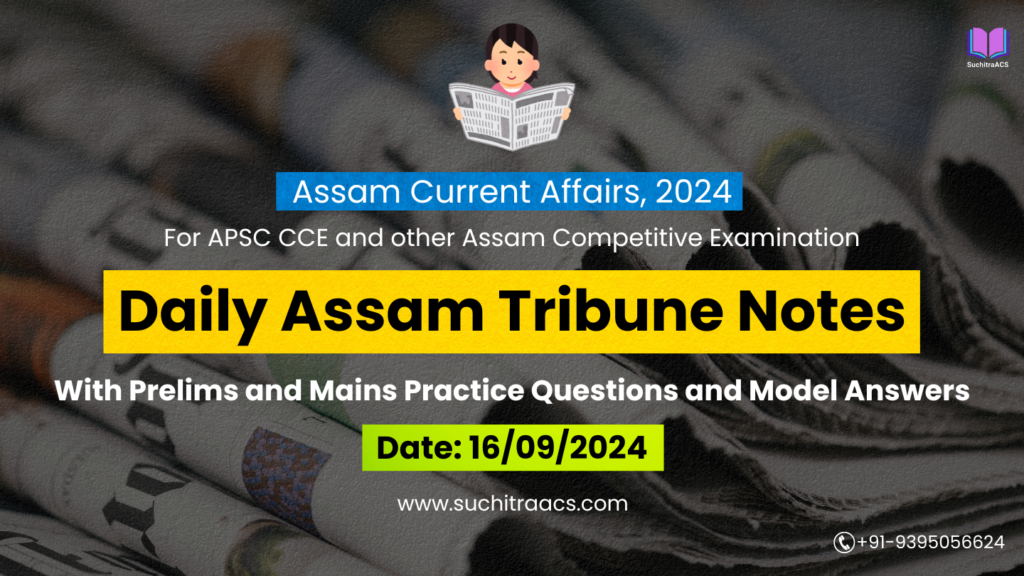APSC Current Affairs: Assam Tribune Notes with MCQs and Answer Writing (20/11/2024)
For APSC CCE and other Assam Competitive examinations aspirants, staying updated with current affairs is vital. This blog covers most important topics from the Assam Tribune today (20-11-2024). These issues are key for both APSC Prelims and Mains preparation, offering insights into the APSC CCE Syllabus.
1. Karimganj to Be Renamed as Sribhumi
- Relevant for: GS Paper 1: Indian Culture; GS Paper 2: Governance
Introduction:
The Assam government has decided to rename Karimganj district as Sribhumi, aligning with its efforts to preserve and promote the state’s cultural heritage. This move aims to emphasize the historical and cultural significance of the region while resonating with Assam’s broader identity-building initiatives.
Key Facts:
- Decision Context: Approved in a recent State Cabinet meeting to reflect cultural and historical narratives.
- Etymology: “Sribhumi” translates to “sacred land,” representing the region’s traditional and spiritual ethos.
- Barak Valley Connection: Karimganj is one of the key districts in Assam’s Barak Valley region.
Prelims Pointers:
- Karimganj District: A prominent cultural and administrative center in Barak Valley.
- Sribhumi: Highlights Assam’s cultural ethos and indigenous heritage.
- Renaming Trend: Part of a broader movement to reclaim traditional and historical names across India.
Mains Pointers:
- Importance:
- Cultural Identity: Reinforces Assamese culture and historical legacy.
- Tourism Development: Elevates the district as a destination of cultural significance.
- Local Pride: Strengthens community pride and awareness of historical roots.
- National Alignment: Reflects national trends of reviving indigenous names.
- Challenges:
- Administrative Burden: Changes in documents, maps, and signages require significant resources.
- Financial Cost: Substantial funds needed for logistical adjustments.
- Inclusivity Issues: Balancing cultural preservation with the concerns of diverse communities.
- Public Resistance: Some sections of the population may view the move as unnecessary.
- Government Initiatives:
- Statewide surveys to identify culturally significant names for potential renaming.
- Public outreach to explain the historical and cultural rationale for renaming.
- Allocation of resources for smooth implementation of the renaming process.
- Way Ahead:
- Foster dialogue with local communities to address concerns inclusively.
- Phase-wise implementation to ensure minimal disruption.
- Leverage the renaming to boost regional identity and tourism.
Conclusion:
Renaming Karimganj to Sribhumi reflects Assam’s commitment to preserving its cultural heritage. While challenges remain, an inclusive and well-executed process can enhance regional pride and align with India’s cultural revival goals.
2. Assam Investment and Infrastructure Summit 2024 Announced
- Relevant for: GS Paper 3: Economy and Infrastructure
Introduction:
The Assam government announced the second Assam Investment and Infrastructure Summit, scheduled for February 2024. This initiative aims to position Assam as a premier investment destination while focusing on regional economic development.
Key Facts:
- Summit Focus Areas: Infrastructure, energy, IT, and tourism sectors.
- Strategic Goal: Attract both domestic and foreign investment to promote Assam’s industrial growth.
- National Alignment: Linked with Make-in-India and Atmanirbhar Bharat initiatives.
Prelims Pointers:
- Assam Investment Summit: A platform to showcase Assam’s industrial and business potential.
- Barak Valley Focus: Efforts to unlock economic growth in this region.
- Ease of Doing Business (EoDB): State initiatives to simplify regulations and attract investments.
Mains Pointers:
- Importance:
- Economic Development: Strengthens Assam’s industrial and infrastructure base.
- Job Creation: Promotes employment and skill development in key sectors.
- Regional Connectivity: Enhances links with India’s Act East Policy.
- Sustainable Growth: Encourages investments in green energy and sustainable industries.
- Challenges:
- Logistical Constraints: Poor connectivity in rural and remote areas.
- Investor Retention: Sustaining long-term interest from investors amid global uncertainties.
- Urban-Rural Divide: Balancing development across urban and rural areas.
- Environmental Impact: Mitigating the ecological effects of large-scale projects.
- Government Initiatives:
- Development of Special Economic Zones (SEZs) and industrial parks.
- Simplified tax regimes and single-window clearance systems for investors.
- Public-private partnerships (PPPs) to enhance project execution.
- Way Ahead:
- Focus on underdeveloped sectors like green energy and agro-industries.
- Strengthen infrastructure, particularly digital and physical connectivity.
- Conduct periodic reviews to ensure investor satisfaction and policy alignment.
Conclusion:
The Assam Investment and Infrastructure Summit is an opportunity to establish Assam as a key player in India’s growth story. Strategic focus on connectivity, sustainability, and inclusive development will maximize its benefits.
3. Wild Elephant Radio-Collared in Baksa
- Relevant for: GS Paper 3: Environment and Biodiversity
Introduction:
The Assam Forest Department, in collaboration with conservation organizations, has radio-collared a wild elephant in Baksa district. This initiative aims to monitor elephant movements, mitigate human-elephant conflict (HEC), and promote wildlife conservation.
Key Facts:
- Location: Baksa district, part of the Manas Biosphere Reserve.
- Objective: Reduce HEC and improve coexistence by tracking high-risk zones.
- Technology: GPS-enabled radio collars for real-time monitoring.
Prelims Pointers:
- Baksa District: A biodiversity hotspot in Assam.
- Radio Collars: Devices for studying animal migration and behavior.
- HEC: A critical challenge in regions with overlapping wildlife habitats and human settlements.
Mains Pointers:
- Importance:
- Conservation Goals: Enhances understanding of migration and habitat use.
- Conflict Mitigation: Reduces crop damage and property loss in rural areas.
- Policy Support: Informs strategies under Project Elephant.
- Community Coexistence: Promotes harmony between humans and wildlife.
- Challenges:
- Technological Limitations: High costs and maintenance of collars.
- Community Resistance: Lack of awareness about the benefits of conservation.
- Habitat Loss: Increasing deforestation and human encroachment.
- Funding Issues: Limited financial resources for large-scale deployment.
- Government Initiatives:
- Strengthening wildlife corridors to facilitate safe elephant movement.
- Collaborations with NGOs for innovative conflict mitigation strategies.
- Community engagement programs to educate locals about HEC solutions.
- Way Ahead:
- Expand radio-collaring projects across Assam’s conflict-prone regions.
- Utilize data for effective conservation planning and policy formulation.
- Balance conservation with sustainable rural development.
Conclusion:
Radio-collaring wild elephants is a crucial step in addressing HEC and conserving Assam’s biodiversity. Strengthened conservation strategies can ensure coexistence between humans and wildlife.
4. Acute Water Shortage in Guwahati
- Relevant for: GS Paper 3: Urbanization, Infrastructure, Governance
Introduction:
Guwahati faced a severe water crisis due to disruptions in the Guwahati Jal Board (GJB) supply system. This exposed systemic inefficiencies in the city’s urban water infrastructure, underscoring the need for better planning and governance.
Key Facts:
- Issue: Shutdown caused by pipeline air blockages and outdated infrastructure.
- Impact: Widespread protests as citizens demanded accountability and immediate solutions.
- Authorities Involved: GJB and state urban development agencies.
Prelims Pointers:
- Guwahati Jal Board (GJB): Responsible for managing the city’s water supply.
- Reservoir Management: Critical for water distribution in urban areas.
- SDG 6: Ensures access to clean water and sanitation for all.
Mains Pointers:
- Importance:
- Public Health: Prevents waterborne diseases through reliable supply.
- Urban Resilience: Prepares cities for growing water demands amid climate change.
- Public Trust: Demonstrates governance efficiency in managing urban crises.
- Sustainability: Reduces over-reliance on groundwater resources.
- Challenges:
- Aging Infrastructure: Frequent pipeline bursts due to outdated systems.
- Demand-Supply Mismatch: Rapid urbanization surpassing existing capacity.
- Public Awareness: Limited understanding of water conservation methods.
- Financial Constraints: Insufficient funds for system upgrades.
- Government Initiatives:
- Upgrading pipeline systems and reservoirs using advanced technology.
- Promoting rainwater harvesting and water recycling.
- Engaging private partners to improve urban water infrastructure.
- Way Ahead:
- Leverage AI and IoT for real-time monitoring and crisis management.
- Conduct public awareness drives on water conservation.
- Ensure timely audits and upgrades of water supply systems.
Conclusion:
Addressing Guwahati’s water crisis requires an integrated approach combining infrastructure development, sustainable urban planning, and active public engagement.
APSC Prelims Practice Questions
1. Karimganj to Be Renamed as Sribhumi
Question 1:
Which of the following statements about Karimganj and its proposed renaming is correct?
- Karimganj is located in Assam’s Barak Valley region.
- The proposed name “Sribhumi” translates to “sacred land.”
- Renaming districts is solely a decision made by the central government.
Select the correct answer using the code given below:
A. 1 and 2 only
B. 2 and 3 only
C. 1, 2, and 3
D. 1 only
Answer: A
Explanation:
- Statement 1 is correct: Karimganj is a district in Assam’s Barak Valley.
- Statement 2 is correct: Sribhumi translates to “sacred land.”
- Statement 3 is incorrect: Renaming districts is primarily a state government’s decision, subject to central approval for gazette notification.
Question 2:
Which of the following factors are often considered when renaming districts in India?
- Preservation of cultural identity
- Boosting tourism potential
- Increasing administrative efficiency
- Enhancing tax revenue collection
Select the correct answer using the code given below:
A. 1 and 2 only
B. 1, 2, and 3 only
C. 1, 3, and 4 only
D. 1, 2, 3, and 4
Answer: B
Explanation:
- Renaming districts is often done to preserve cultural identity and historical legacy (Statement 1) and to boost tourism by emphasizing cultural significance (Statement 2).
- Administrative efficiency (Statement 3) may also be a secondary consideration, but tax revenue collection (Statement 4) is not typically linked to renaming districts.
2. Assam Investment and Infrastructure Summit 2024
Question 3:
Which of the following sectors are the primary focus of the Assam Investment and Infrastructure Summit 2024?
- Information Technology
- Green Energy
- Tourism
- Heavy Manufacturing
Select the correct answer using the code given below:
A. 1, 2, and 3 only
B. 2 and 3 only
C. 1, 2, 3, and 4
D. 1 and 4 only
Answer: A
Explanation:
- The summit focuses on IT, green energy, and tourism as priority sectors, while heavy manufacturing is not explicitly highlighted in the initiatives.
Question 4:
What is the “Ease of Doing Business” initiative primarily aimed at?
A. Increasing Foreign Direct Investment (FDI) in India
B. Simplifying regulatory processes for businesses
C. Enhancing labor law flexibility
D. Improving export competitiveness
Answer: B
Explanation:
- The Ease of Doing Business initiative is designed to simplify regulatory processes, streamline approvals, and make it easier for businesses to operate.
3. Wild Elephant Radio-Collared in Baksa
Question 5:
What is the primary purpose of radio-collaring wild elephants?
- To monitor migration patterns
- To reduce human-elephant conflicts
- To track illegal poaching activities
- To assist in medical treatment of elephants
Select the correct answer using the code given below:
A. 1 and 2 only
B. 1, 2, and 3 only
C. 2 and 3 only
D. 1, 2, 3, and 4
Answer: A
Explanation:
- Radio collars are used to track migration patterns (Statement 1) and reduce human-elephant conflicts (Statement 2). While it may indirectly help combat poaching, it is not the primary goal (Statement 3). Medical treatment (Statement 4) is not a stated objective.
Question 6:
Which of the following is true about the Manas Biosphere Reserve?
- It is part of the UNESCO World Network of Biosphere Reserves.
- It is located in the Baksa district of Assam.
- It is known for housing a significant population of wild elephants.
Select the correct answer using the code given below:
A. 1 and 2 only
B. 2 and 3 only
C. 1 and 3 only
D. 1, 2, and 3
Answer: D
Explanation:
- All statements are correct: The Manas Biosphere Reserve is a UNESCO-recognized site located in Baksa and is a key habitat for wild elephants.
4. Acute Water Shortage in Guwahati
Question 7:
Which of the following are potential solutions to address urban water crises like the one in Guwahati?
- Modernizing pipeline infrastructure
- Promoting rainwater harvesting
- Expanding groundwater extraction
- Increasing public awareness of water conservation
Select the correct answer using the code given below:
A. 1 and 2 only
B. 1, 2, and 4 only
C. 1, 3, and 4 only
D. 2, 3, and 4 only
Answer: B
Explanation:
- Solutions include modernizing pipelines (Statement 1), promoting rainwater harvesting (Statement 2), and increasing public awareness (Statement 4). Expanding groundwater extraction (Statement 3) is not sustainable and can lead to long-term depletion.
Question 8:
The Sustainable Development Goal (SDG) 6 focuses on:
A. Affordable and Clean Energy
B. Clean Water and Sanitation
C. Sustainable Cities and Communities
D. Life Below Water
Answer: B
Explanation:
SDG 6 aims to ensure availability and sustainable management of water and sanitation for all.
APSC Mains Practice Question
Topic: Karimganj Renaming as Sribhumi
GS Paper 1: Indian Culture; GS Paper 2: Governance
The renaming of districts often reflects efforts to preserve cultural identity and historical significance. Analyze the implications of renaming Karimganj as Sribhumi. Discuss the potential benefits and challenges of such initiatives in a diverse country like India.
Model Answer
Introduction:
The recent decision by the Assam government to rename Karimganj district as Sribhumi underscores a growing trend in India to reclaim and preserve indigenous cultural identities. While this move seeks to highlight the historical and cultural significance of the region, it raises questions about inclusivity, administrative feasibility, and community acceptance in a diverse society.
Implications of Renaming Karimganj as Sribhumi:
1. Benefits:
- Cultural Revival: The name “Sribhumi” emphasizes the region’s historical and spiritual significance, reinforcing Assam’s unique cultural identity.
- Tourism Development: A culturally significant name can enhance the region’s appeal, attracting tourists interested in Assam’s heritage.
- Local Pride: Strengthens regional identity and fosters pride among residents.
- National Trends: Aligns with India’s broader movement to reclaim indigenous names, such as Prayagraj and Ayodhya.
2. Challenges:
- Community Inclusivity: Assam’s Barak Valley is home to diverse communities, and such changes may alienate linguistic or cultural minorities.
- Administrative Burden: Renaming requires significant changes in documents, maps, and infrastructure, demanding resources and time.
- Public Opposition: Sections of the population may perceive the move as unnecessary or politically motivated, leading to protests.
- Economic Costs: The process involves financial outlays for updating records, public signages, and official materials.
Way Forward:
To balance cultural preservation and inclusivity, the government can adopt the following measures:
- Stakeholder Consultation: Engage with local communities and minority groups to ensure their concerns are addressed and consensus is built.
- Phased Implementation: Gradually introduce the new name to minimize administrative disruption and financial costs.
- Cultural Awareness Campaigns: Educate the public about the historical significance of the name to foster widespread acceptance.
- Link Renaming with Development Initiatives: Combine renaming efforts with tangible improvements in infrastructure and tourism to enhance public support.
Conclusion:
Renaming Karimganj as Sribhumi represents an effort to preserve Assam’s rich cultural legacy while promoting regional pride. However, it is essential to ensure that such initiatives are inclusive, economically feasible, and sensitive to the diverse demographic composition of the region. Striking this balance will uphold India’s pluralistic ethos while celebrating its heritage.
✨ APSC Prelims Crash Course, 2025
at most affordable rate in Assam!

🔔 Join Our WhatsApp Study Group!
For exclusive access to premium quality content, including study materials, current affairs, MCQs, and model answers for APSC CCE and other Assam competitive exams.
Click here to join: SuchitraACS Study WhatsApp Group
📚 Want to know more about SuchitraACS’s most affordable courses?
Click here to know more: SuchitraACS Courses for APSC CCE and Assam Competitive Examinations




